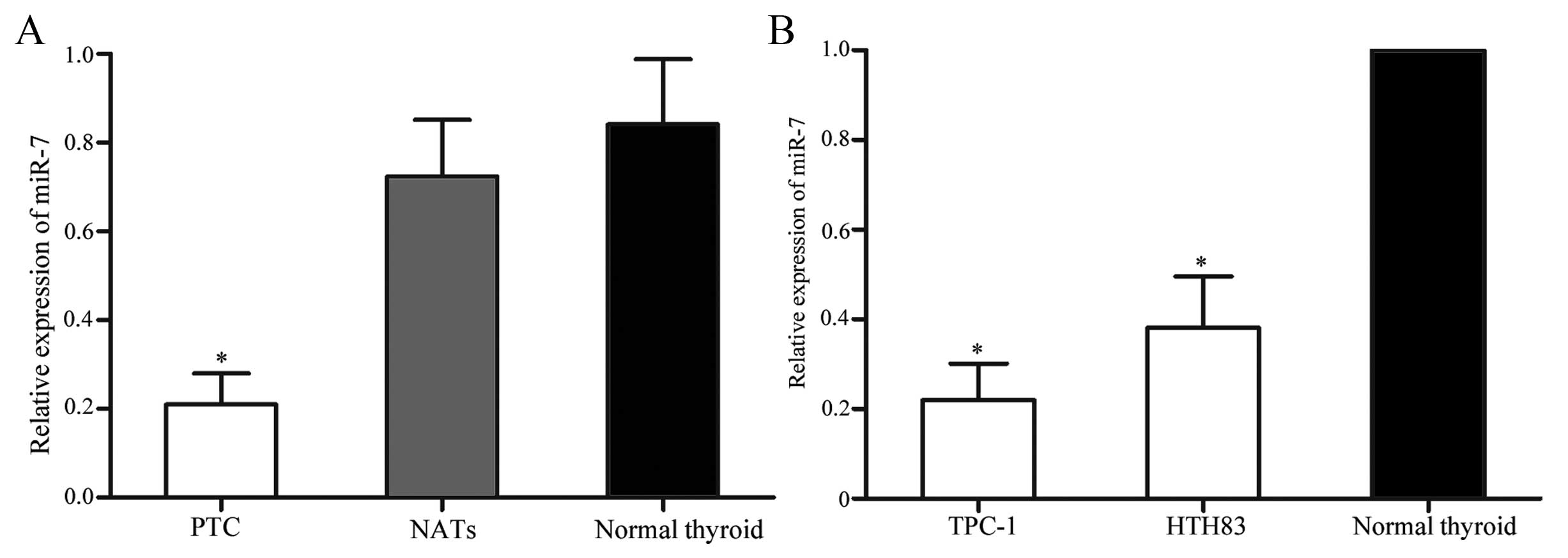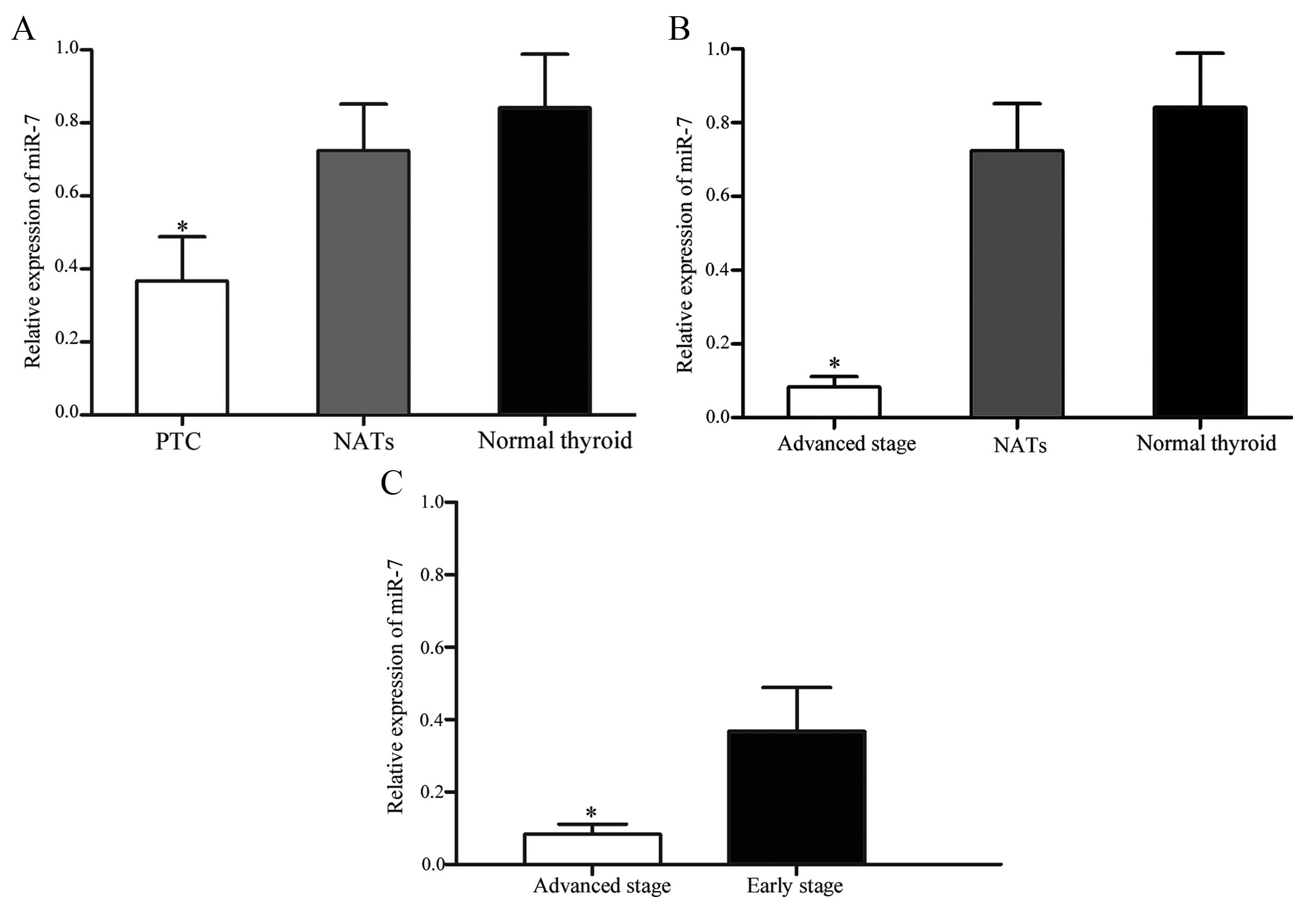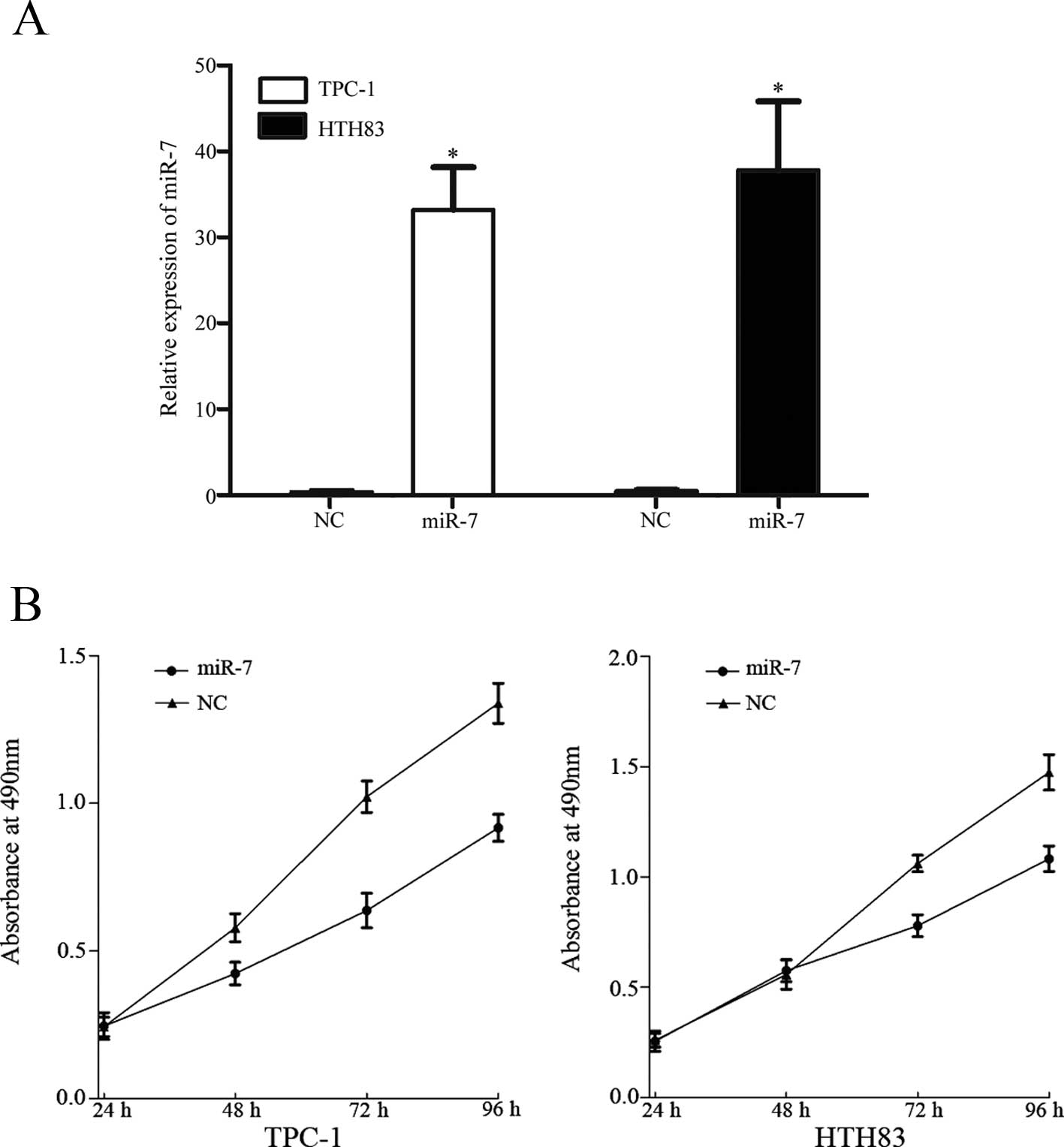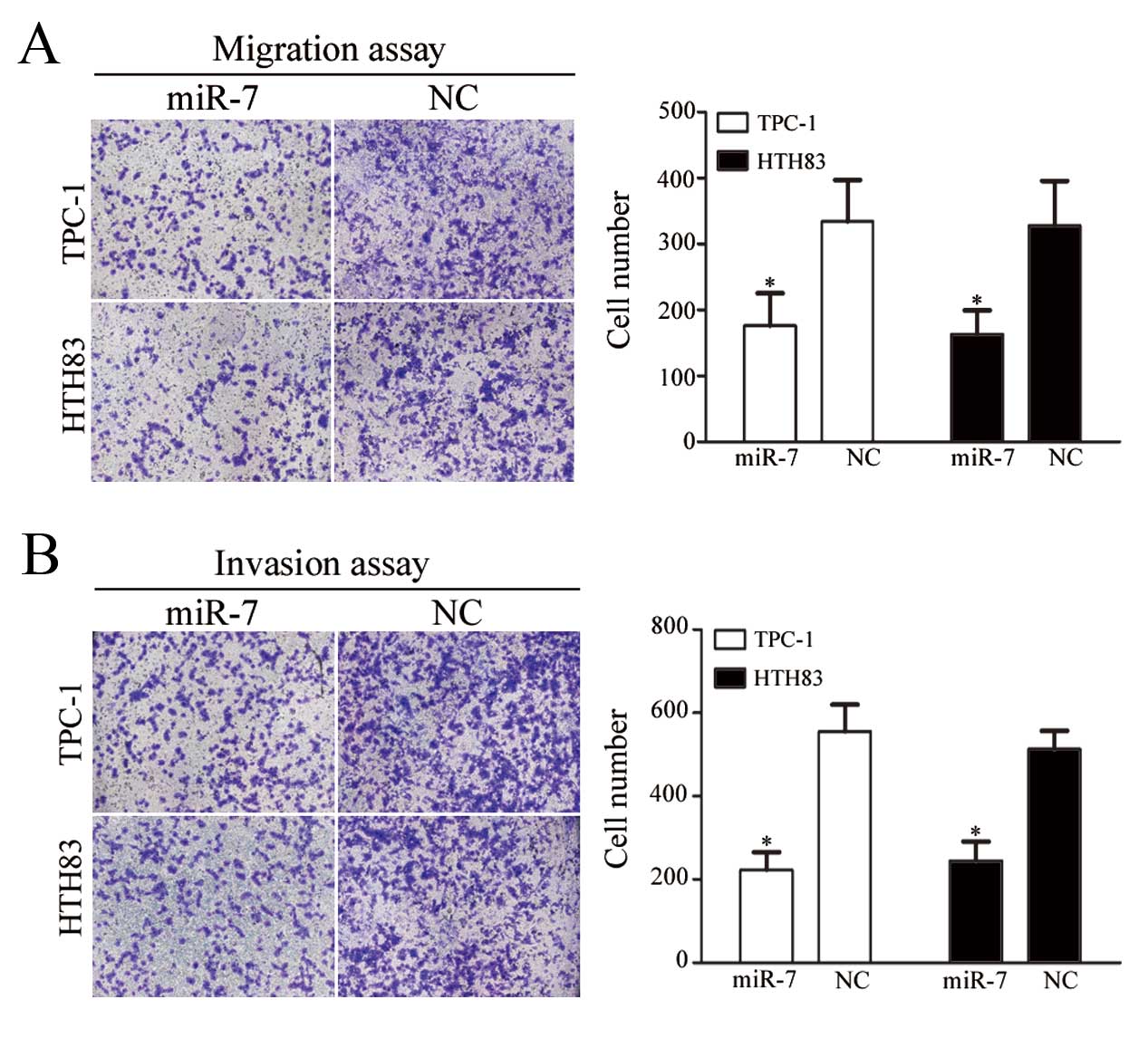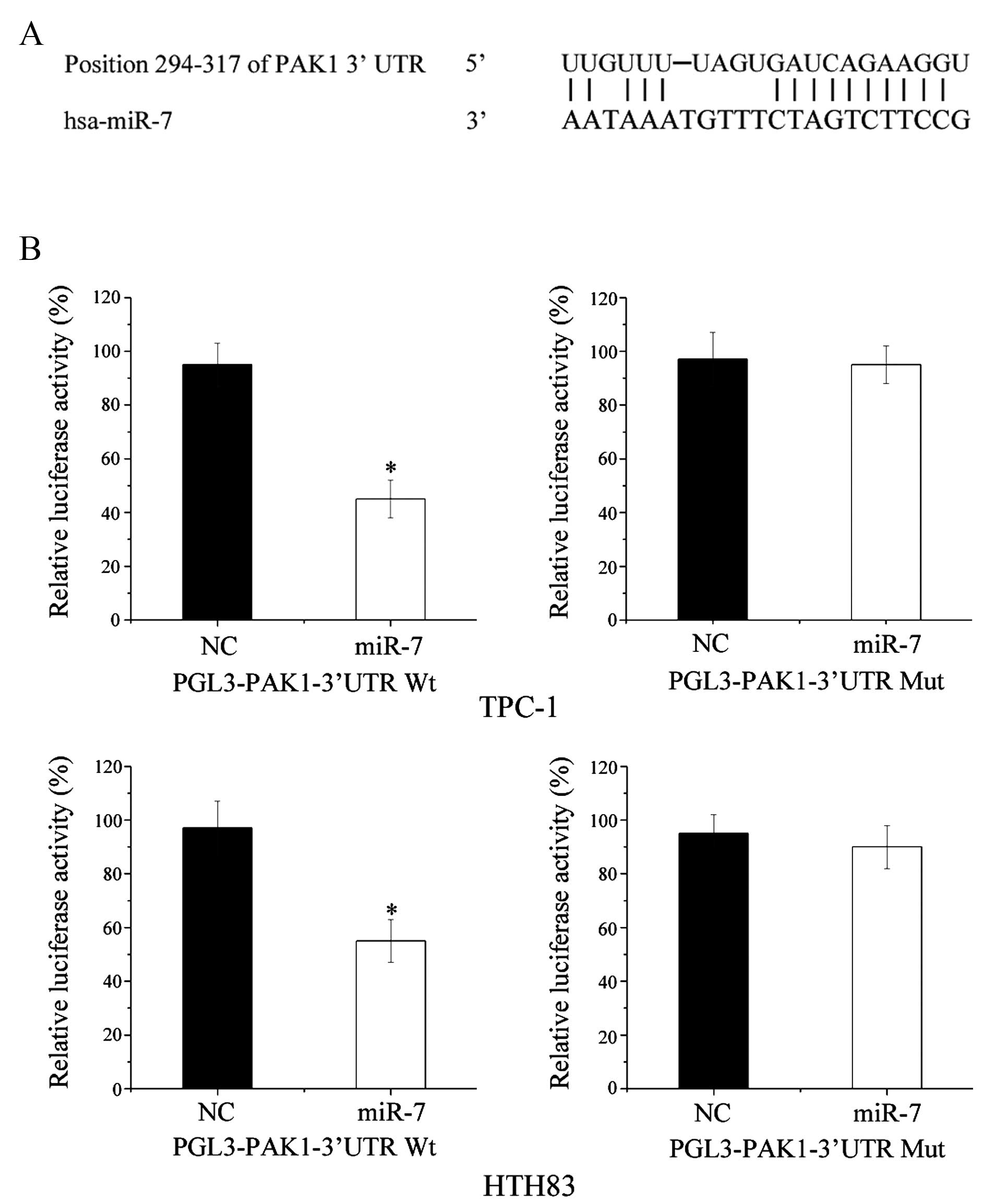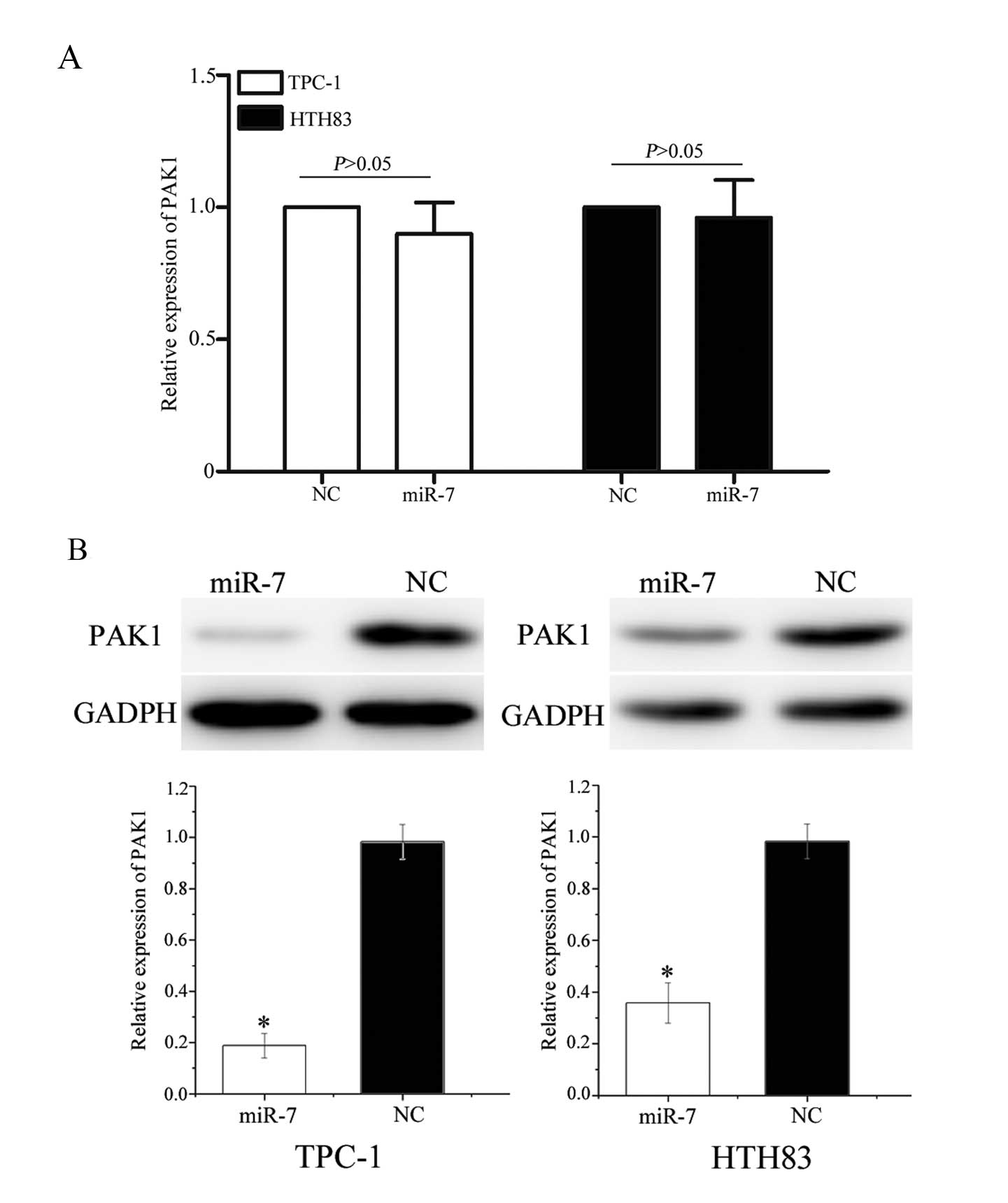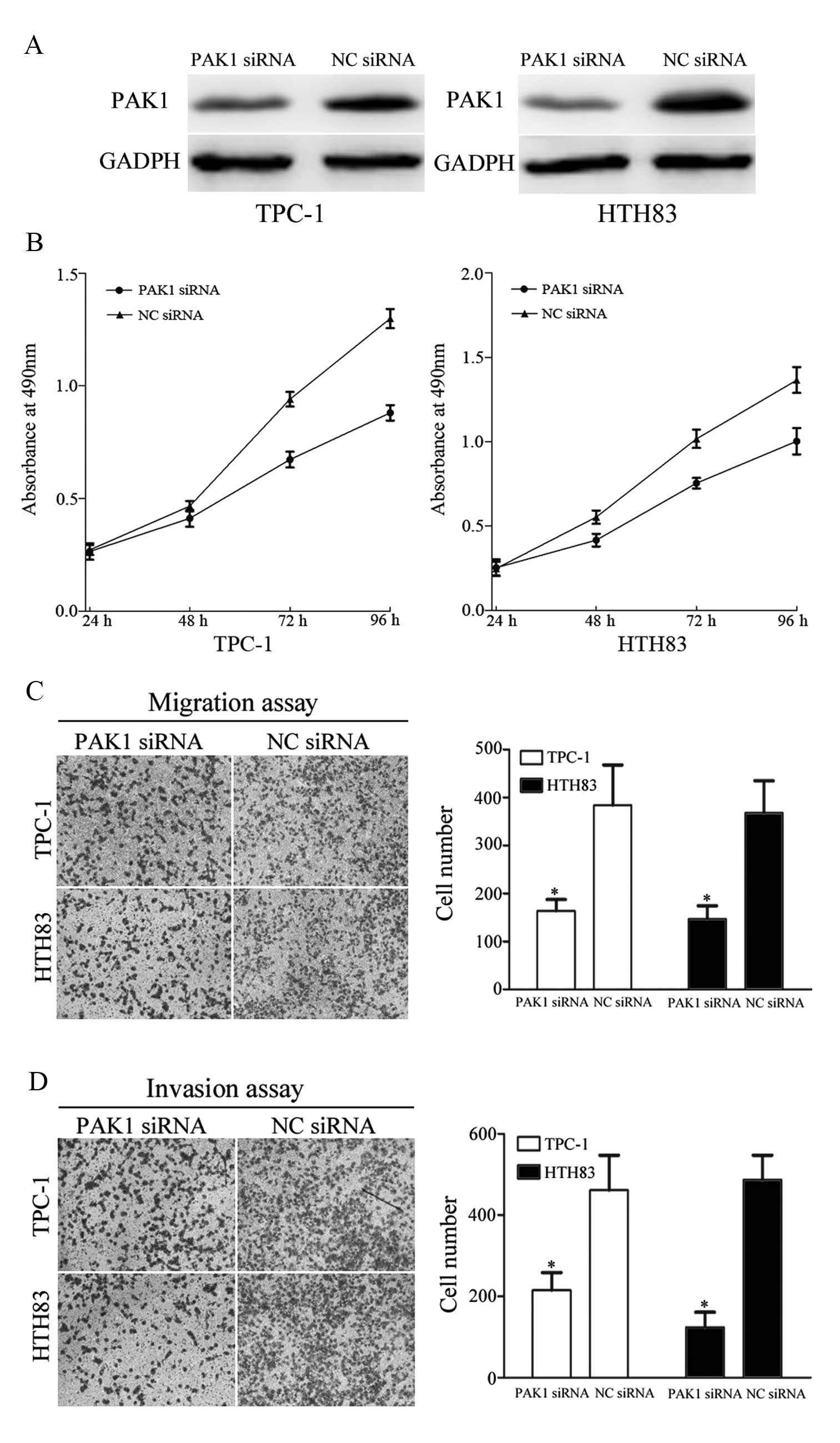microRNA-7 regulates cell growth, migration and invasion via direct targeting of PAK1 in thyroid cancer
Retraction in: /10.3892/mmr.2023.12992
- Authors:
- Published online on: July 7, 2016 https://doi.org/10.3892/mmr.2016.5477
- Pages: 2127-2134
Abstract
Introduction
Thyroid cancer, derived from the thyroid follicular cells, is the most common malignancy of the endocrine system (1). The incidence of thyroid cancer over the last three decades has increased in the USA, typically due to improved detection of sub-clinical tumors (2). There are four major histological types including papillary thyroid carcinoma (PTC), follicular thyroid carcinoma (FTC), poorly differentiated carcinoma and undifferentiated anaplastic carcinoma (ATC) (3). PTC is the most common type of thyroid cancer and accounts for ~80% of cases (4). The prognosis of PTC is related to patient age, tumor size and histological parameters including extra-capsular extension, extra-thyroidal extension, lymph node invasion, distant metastases and histological variant (5). The majority of PTC cases demonstrate a good prognosis; however, in a few cases it can recur, transform or metastasize, which can lead to disease-related mortality (6). Metastasis of thyroid tumors often confers a poor prognosis and is the major cause of mortality (7). Therefore, the identification of factors associated with metastasis, is important for the development of novel targeted therapies for thyroid cancer treatment.
In thyroid cancer, abnormal microRNA (miRNA) expression has been observed in PTC (8–10), FTC (11) and ATC (12) tumor subtypes. miRNAs belong to a group of endogenous, non-protein-coding, single-stranded, small RNAs that are 20–24 nucleotides in length (13). Previous studies have demonstrated that miRNAs are involved in major physiological and pathological cellular pathways including cell growth, differentiation, cell cycle, apoptosis, migration and invasion (14). In the majority of cases, miRNAs function to prohibit the expression of specific genes by interacting preferentially and base-pairing with the 3′-untranslated region (UTR) of targeted mRNA sequences, which results in mRNA cleavage and repression of translation (15). miRNAs can be divided into onco-miRNAs and tumor-suppressive miRNAs. Onco-miRNAs are upregulated in human cancer and function to promote cell proliferation and inhibit apoptosis, whereas tumor-suppressive miRNAs are downregulated in human cancer and can prevent cancer development (16–18). Of particular note, miRNAs have received widespread attention as a potential targeted therapy (19). Therefore, the use of miRNA sequences for the diagnosis, treatment and prognosis of cancer could be beneficial.
In the present study, the expression and molecular function of miR-7 in human thyroid cancer was investigated. The results presented in this study reveal that miR-7 is downregulated in human thyroid cancer tissues and cells. miR-7 expression levels were also observed to be associated with thyroid cancer tumor stage. In addition, ectopic expression of miR-7 suppressed thyroid cancer cell proliferation, migration and invasion. Moreover, p21-activated kinase 1 (PAK1) was identified as a novel miR-7 target. Silencing of PAK1 in thyroid tumor cell lines was observed to confer a similar phenotypic effect on cell growth, migration and invasion as ectopic expression of miR-7. Ultimately, these results suggest that miR-7 may function as a tumor suppressor by regulating cell growth, migration and invasion via direct targeting of PAK1, and should therefore be investigated as a novel putative target for the treatment of thyroid cancer.
Materials and methods
Clinical specimens
A total of 32 human PTC tissue pairs, matched normal adjacent tissues (NATs) and six normal thyroid tissue samples, were collected from Tianjin Medical University Cancer Institute and Hospital (Tianjin, China). This study was approved by Tianjin Medical University Cancer Institute and Hospital's Protection of Human Subjects Committee and written informed consent was also obtained from all patients with thyroid cancer. Patients included in the present study had not received chemotherapy or radiothera py prior to surgery. Tissue samples were immediately snap frozen in liquid nitrogen following surgery and stored at −80°C until required.
Cell culture and transfection
Human PTC cell lines, TPC-1 and HTH83, were purchased from the Shanghai Institute of Biochemistry and Cell Biology (Shanghai, China). Cell lines were maintained in Dulbecco's modified Eagle's medium (DMEM) with 10% (v/v) fetal bovine serum (FBS), 100 IU/ml penicillin and 100 µg/ml streptomycin (Gibco; Thermo Fisher Scientific, Inc., Waltham, MA, USA) in a humidified 5% (v/v) CO2 cell incubator at 37°C.
Mature miR-7 mimics, negative controls (NC), PAK1 small interfering RNA (siRNA), NC siRNA and luciferase reporter plasmids were synthesized and obtained from Shanghai GenePharma Co., Ltd., (Shanghai, China). Cells were seeded onto a 6-well plate and cultured in complete DMEM without antibiotics. Transfections and co-transfections were performed when cells had reached 30–40% confluence using Lipofectamine 2,000 (Invitrogen; Thermo Fisher Scientific, Inc., Carlsbad, CA, USA) according to the manufacturer's instructions.
RNA isolation and reverse transcription-quantitative polymerase chain reaction (RT-qPCR)
Total RNA was extracted from human PTC tissues, NATs, normal thyroid tissue samples, TPC-1 cells and HTH83 cells using TRIzol reagent (Invitrogen; Thermo Fisher Scientific, Inc.) according to the manufacturer's instructions. For detection of miR-7 expression, reverse transcription was performed using the M-MLV Reverse Transcription system (Promega Corporation, Madison, WI, USA). Following, reverse transcription, qPCR was performed using SYBR green I mix (Takara Biotechnology Co., Ltd., Dalian, China) according to the manufacturer's instructions. Each sample was analyzed in triplicate. U6 small nuclear RNA (snRNA) and glyceraldehyde 3-phosphate dehydrogenase (GADPH) were used as internal controls. All primers were obtained from Guangzhou RiboBio Co., Ltd. (Guangzhou, China). Gene expression was quantified using the 2−ΔΔCq method.
MTT assay
Analysis of cell growth was achieved using the MTT assay. At 24 h following transfection, cells were seeded on 96-well plates at 3,000 cells/well. The MTT assay was performed at 24, 48, 72 and 96 h. Briefly, 20 µl MTT (5 mg/ml; Sigma-Aldrich, St. Louis, MO, USA) was added into each sample. The 96-well plates were then incubated at 37°C for 4 h. Cell culture medium was subsequently removed and formazan precipitates were dissolved in 200 µl dimethylsulfoxide. A microplate reader (Model 550; Bio-Rad Laboratories, Inc., Hercules, CA, USA) was used to read the absorbance at 490 nm for each sample. Suppression rate was calculated using the following formula: Suppression rate = (1-A490miR-7/A490NC) x100%. Experiments were performed in triplicate.
Cell migration and invasion assay
In vitro cell migration and invasion assays were performed using Transwell® chambers (Corning, Inc., Corning, NY, USA). For the migration assay, 4×104 transfected cells cultured in 200 µl DMEM without FBS, were added into the top chamber. For the invasion assay, 4×104 transfected cells in 200 µl DMEM without FBS were placed into the top chamber coated with Matrigel (BD Biosciences, Franklin Lakes, CA, USA). For both assays, 500 µl DMEM containing 20% FBS was then added to the lower chamber as a chemo-attractant. Following 24 h incubation, cells were fixed with 100% methanol (Beyotime Institute of Biotechnology, Haimen, China) and stained with 0.5% crystal violet (Beyotime Institute of Biotechnology). Cells that had not migrated or invaded through the 8-µm pores, were removed carefully with a cotton swab. For every sample, five fields (magnification, x200) were imaged at random using an inverted microscope (Olympus Corporation, Tokyo, Japan). Experiments were performed in triplicate.
Targeting of miR-7
TargetScan (http://www.targetscan.org) software program was used to search for miR-7 target genes.
Western blot analysis
Goat anti-human PAK1 (sc-31685) and mouse anti-human GADPH primary antibodies (sc-166574) were obtained from Santa Cruz Biotechnology, Inc. (Dallas, TX, USA). At 72 h following transfection, cells were washed with phosphate-buffered saline (PBS) and lysed in radioimmunoprecipitation assay (RIPA) lysis buffer (Beyotime Institute of Biotechnology). Equal quantities of protein were separated using 10% sodium dodecyl sulphate-polyacrylamide gel electrophoresis and electroblotted onto polyvinylidene fluoride membranes (EMD Millipore, Billerica, MA, USA). Membranes were blocked in PBS containing 0.1% Tween® 20 (Beyotime Institute of Biotechnology) and 5% non-fat dry milk. The membranes were then probed with PAK1 (1:1,000) or GADPH (1:1,000) primary antibody for an overnight incubation at 4°C. Corresponding secondary antibodies (sc-2354 for PAK1; sc-2005 for GADPH; Santa Cruz Biotechnology, Inc.) were then added followed by incubation at 1:1,000 dilution in Tris-buffered saline with Tween® 20. Protein bands were detected using enhanced chemiluminescence solution (Pierce Biotechnology, Inc., Rockford, IL, USA) and band intensities were quantified using the FluorChem imaging system (alpha innotec, GmbH, Kasendorf, DE).
Dual-luciferase reporter assay
Dual-luciferase reporter assays were performed to determine whether PAK1 was a direct target of miR-7. For miRNA target validation, cells were transfected with miR-7 mimics or NC, and co-transfected with PGL3-PAKl-3′-UTR wild-type (wt) or PGL3-PAKl-3′-UTR mutant (mut) in three independent experiments. At 48 h following transfection, firefly and Renilla luciferase activities were detected with the Dual-Luciferase Reporter assay system (Promega Corporation). Renilla luciferase activity was used as an internal control.
Statistical analysis
Data were presented as the mean ± standard deviation. and analyzed using SPSS software (version 17.0; SPSS, Inc., Chicago, IL, USA). Differences were considered significant if P-values were <0.05.
Results
PTC tissues and cell lines express lower levels of miR-7 compared with normal thyroid tissues
The expression of miR-7 in PTC tissues, matched NATs, normal thyroid tissues and PTC cell lines was determined using RT-qPCR. As shown in Fig. 1A, miR-7 was significantly downregulated in PTC tissues when compared with matched NATs (P=0.015) and normal thyroid tissues (P=0.007). Downregulation of miR-7 was also observed in TPC-1 and HTH83 cells compared with normal thyroid tissues ((P=0.010 for TPC-1; P=0.012 for HTH83). These results suggest that miR-7 may play tumor-suppressive role in PTC.
Association between miR-7 expression and thyroid tumor stage
In order to investigate an association between miR-7 expression and thyroid tumor stage, statistical analysis was performed. Patients with thyroid cancer were divided into early-stage (T1 and T2) and advanced-stage (T3 and T4) groups. The expression levels of miR-7 in early-stage (P=0.025; Fig. 2A) and advanced-stage (P=0.005; Fig. 2B) groups were significantly lower than NATs and normal thyroid tissues. In addition, miR-7 expression in the advanced-stage group was significantly downregulated compared with the early-stage group (P=0.034; Fig. 2C). These results suggest that lower levels of miR-7 expression are associated with increased thyroid tumor stage.
miR-7 suppresses TPC-1 and HTH83 cell proliferation
To investigate the role of miR-7 in TPC-1 and HTH83 cells, miR-7 and NC miRNA mimics were transfected into TPC-1 and HTH83 cells. At 48 h following transfection, total cell RNA was extracted and RT-qPCR was performed to analyze the expression of miR-7. As shown in Fig. 3A, miR-7 was significantly upregulated in TPC-1 and HTH83 cells transfected with miR-7 mimics compared with controls (P=0.001).
The MTT assay was selected to investigate the effect of miR-7 on cell proliferation. As shown in Fig. 3, upregulation of miR-7 significantly inhibited cell proliferation of TPC-1 (P=0.018) and HTH83 (P=0.031) cells when compared with controls. This provides further support to the hypothesis that miR-7 functions as a tumor suppressor in human thyroid cancer.
miR-7 suppresses TPC-1 and HTH83 cell migration and invasion
The next aim of the study was to investigate the role of miR-7 on TPC-1 and HTH83 cell migration and invasion. As shown in Fig. 4A and B, miR-7-transfected TPC-1 and HTH83 cells demonstrated a significant reduction in cell migration (P=0.034 and P=0.029, respectively) and invasion (P=0.021 and P=0.028, respectively) compared with NC-transfected cells.
PAK1 is a direct target of miR-7 in vitro
In order to investigate the potential mechanism by which miR-7 regulates thyroid cancer cell growth, migration and invasion the online TargetScan software program was used to search for miR-7 target genes. As shown in Fig. 5A, PAK1 was predicted to be a direct target of miR-7.
Dual-luciferase reporter assays were performed to confirm whether PAK1 was a direct biological target of miR-7. As shown in Fig. 5B, miR-7 significantly inhibited PGL3-PAKl-3′-UTR wt but not PGL3-PAKl-3′-UTR mut luciferase activity in TPC-1 and HTH83 cells (P=0.022 and P=0.026, respectively). These results indicate that PAK1 is a direct target of miR-7 in vitro.
miR-7 negatively regulates PAK1 expression at a post-transcriptional level
To investigate an association between miR-7 and PAK1 at the mRNA and protein levels, miR-7 or NC miRNA mimics were transfected into TPC-1 and HTH83 cells. PAK1 mRNA levels were measured using RT-qPCR and protein expression was determined using western blot analysis. As shown in Fig. 6A, PAK1 mRNA levels were not significantly altered following transfection with miR-7 mimics (P=0.715 and P=0.812, respectively). However, western blot analysis revealed that the expression of PAK1 was significantly downregulated in TPC-1 and HTH83 cells transfected with miR-7 mimics compared with controls (Fig. 6B, P=0.020 and P=0.028, respectively). These results suggest that miR-7 regulates PAK1 expression at the post-transcriptional level.
PAK1 is implicated in the effects of miR-7 on TPC-1 and HTH83 cell growth migration and invasion
To determine whether PAK1 functions as a critical mediator of miR-7 in TPC-1 and HTH83 cell growth, migration and invasion, these cells were transfected with PAK1 siRNA and NC siRNA to silence PAK1 expression. At 72 h following transfection, western blot analysis demonstrated that PAK1 was down-regulated in TPC-1 and HTH83 cells transfected with PAK1 siRNA compared with controls (Fig. 7A, P=0.031 and P=0.027, respectively).
As shown in Fig. 7B, treatment of TPC-1 and HTH83 cells with PAK1 siRNA significantly inhibited cell growth compared with controls (P=0.014 and P=0.029, respectively). In addition, migration and invasion assays revealed that PAK1 siRNA markedly suppressed TPC-1 and HTH83 cells migration (P=0.037 and P=0.023, respectively) and invasion (P=0.039 and P=0.016, respectively) compared with controls. These results demonstrate that reduced PAK1 expression confers a similar phenotype as increased miR-7 expression in TPC-1 and HTH83 cells. Due to the putative interaction between miR-7 and PAK1, it is possible that miR-7 regulates tumor cell growth, migration and invasion through direct targeting of PAK1.
Discussion
Over the last decade, accumulating evidence suggests that aberrant miRNA expression is a common feature of malignancy, including thyroid cancer (20–22). miR-7 is an intronic miRNA sequence located in the first intron of hnRNPK and PGSF1 genes on human chromosomes 9 and 19, respectively (23). An increasing number of studies have demonstrated that miR-7 is downregulated in multiple human tumor types including breast cancer (24), hepatocellular carcinoma (HCC) (25), cervical cancer (26) and colorectal cancer (27). However, to date, no study has investigated the expression of miR-7 in thyroid cancer. In the present study, miR-7 was observed to be significantly downregulated in human PTC tissues and PTC cell lines. The expression level of miR-7 was also found to be associated with thyroid tumor stage. This suggests that miR-7 may play an important role in thyroid cancer progression.
Previous studies have shown that miR-7 may function as a tumor suppressor in multiple tumor types (23–26,28,29,31). miR-7 was found to be significantly downregulated in human cervical cancer, and ectopic expression of miR-7 was observed to inhibit cell metastasis and invasion by targeting focal adhesion kinase (FAK) (26). In human breast cancer cells, miR-7 decreased cell proliferation, migration, invasion and induced apoptosis through targeting proteasome activator subunit 3 and FAK (24,28). Lee et al (23) also observed that miR-7 increased the radiosensitivity of breast cancer cells with activated epidermal growth factor receptor-associated signaling. In human HCC, miR-7 suppressed cell growth, motility and caused cell cycle arrest in G1 through targeting the phosphoinositide 3-kinase (PI3K)/Akt pathway and cyclin E1 (CCNE1) (25,29). Previous studies also demonstrated that miR-7 inhibits glioma cells growth, glucose metabolism, migration, invasion and tumorigenesis by targeting focal adhesion kinase, insulin-like growth factor 1, eukaryotic translation initiation factor 5A, annexin A4, PI3K/ATK and Raf/MEK/ERK pathways (30–33). These results suggest that miR-7 plays an important tumor suppressive role in these cancer types, and may therefore serve as a potential therapeutic target for the treatment of these cancers.
To date, numerous studies have provided evidence to suggest that miR-7 functions as a tumor suppressor; however, others have reported that miR-7 may play an oncogenic role in certain tumor types (34). miR-7 expression was observed to be upregulated in lung cancer compared with NATs, and was negatively correlated with disease-free survival. Moreover, miR-7 promoted cell growth and tumor formation by targeting the ERF tumor suppressor (35). Consistent with these results, miR-7 was observed to be upregulated in renal cell carcinoma, and downregulation of miR-7 decreased cell growth, migration and induced apoptosis (36). These conflicting observations suggest that miR-7 has a tumor and tissue-specific expression pattern and function. In the present study, we demonstrate that miR-7 inhibits thyroid cancer cell proliferation, migration and invasion, which provides additional information about the functional role of miR-7 in human cancer.
Identification of miR-7 target genes is important for understanding its role in tumorigenesis and tumor progression. It is also important for developing novel targeted therapies. In the present study, an important functional link between miR-7 and PAK1 was identified in thyroid cancer. The TargetScan online software tool predicted that PAK1 was a direct target gene of miR-7. Using a dual-luciferase reporter assay, we then confirmed that miR-7 targets the PAK1 3′-UTR directly in vitro. RT-qPCR and western blot analysis revealed that miR-7 does not affect PAK1 mRNA stability, but decreases PAK1 expression at the post-transcriptional level. Knockdown of PAK1 also significantly inhibited thyroid cancer cell proliferation, migration and invasion. PAK1 was therefore thought to be involved in miR-7-induced effects in TPC-1 and HTH83 cells. These results suggest that miR-7 may play a tumor suppressive role in thyroid cancer initiation and progression by targeting PAK1 directly.
In 1994, Manser et al (37) discovered PAKs during a screen for novel proteins that interact with small rho-like G proteins. PAKs have a common molecular weight of 21 kDa, and are known collectively as p21 proteins. In humans and other mammals, PAKs are a class of non-receptor serine/threonine kinases with six known isoforms (PAK 1-6) (38). Based on their sequences and functional similarities, PAKs have been classified into two groups: Group I (PAK1, PAK2 and PAK3) and group II (PAK4, PAK5 and PAK6) (39). PAKs have been observed to play important roles in physiological processes including motility, survival, mitosis, transcription and translation (40,41). PAK1 has been demonstrated to be a key regulator of cancer-related signaling pathways (39). An increasing number of studies have also identified an association between PAK1 expression and tumor progression, which suggests that PAK1 may be a promising diagnostic and therapeutic target for cancers (42–46). In thyroid cancer, PAK1 has been observed to be upregulated in the invasive fronts of human thyroid cancer tissues. Moreover, functional studies have revealed that PAK1 is involved in cell migration and metastasis (47,48). Therefore, PAK1 may represent a novel anti-cancer target for the treatment of thyroid cancer and requires further investigation. In the present study, we identified miR-7 as a negative regulator of PAK1 expression, which functions to decrease thyroid cancer cell growth, migration and invasion. Therefore, the use of miR-7 as a target of PAK1 in thyroid cancer treatment, should be investigated in future studies.
In conclusion, the results of the present study indicate that miR-7 is downregulated in thyroid cancer tissue samples and cell lines compared with normal thyroid tissue samples. An association between miR-7 and tumor stage was also identified. The results presented provide evidence to suggest that miR-7 inhibits thyroid cancer cell proliferation, migration and invasion via the direct targeting of PAK1. miR-7 should therefore be investigated as a potential target for the treatment of thyroid cancer. Further studies will be required to determine the efficacy of miR-7 as an anti-cancer target for thyroid cancer treatment.
Acknowledgments
This study was supported by the Tianjin Cancer Hospital Research Fund (grant no. 1305).
References
|
Braun J, Hoang-Vu C, Dralle H and Hüttelmaier S: Downregulation of microRNAs directs the EMT and invasive potential of anaplastic thyroid carcinomas. Oncogene. 29:4237–4244. 2010. View Article : Google Scholar : PubMed/NCBI | |
|
Vriens MR, Weng J, Suh I, Huynh N, Guerrero MA, Shen WT, Duh QY, Clark OH and Kebebew E: MicroRNA expression profiling is a potential diagnostic tool for thyroid cancer. Cancer. 118:3426–3432. 2012. View Article : Google Scholar | |
|
Hartmann C, Mueller W and von Deimling A: Pathology and molecular genetics of oligodendroglial tumors. J Mol Med (Berl). 82:638–655. 2004. View Article : Google Scholar | |
|
Geraldo MV, Fuziwara CS, Friguglieti CU, Costa RB, Kulcsar MA, Yamashita AS and Kimura ET: MicroRNAs miR-146-5p and let-7f as prognostic tools for aggressive papillary thyroid carcinoma: A case report. Arq Bras Endocrinol Metabol. 56:552–557. 2012. View Article : Google Scholar | |
|
Lv M, Zhang X, Li M, Chen Q, Ye M, Liang W, Ding L, Cai H, Fu D and Lv Z: miR-26a and its target CKS2 modulate cell growth and tumorigenesis of papillary thyroid carcinoma. PLoS One. 8:e675912013. View Article : Google Scholar : PubMed/NCBI | |
|
Peng Y, Li C, Luo DC, Ding JW, Zhang W and Pan G: Expression profile and clinical significance of microRNAs in papillary thyroid carcinoma. Molecules. 19:11586–11599. 2014. View Article : Google Scholar : PubMed/NCBI | |
|
Hunt JP, Buchmann LO, Wang L and Abraham D: An analysis of factors predicting lateral cervical nodal metastases in papillary carcinoma of the thyroid. Arch Otolaryngol Head Neck Surg. 137:1141–1145. 2011. View Article : Google Scholar : PubMed/NCBI | |
|
He H, Jazdzewski K, Li W, Liyanarachchi S, Nagy R, Volinia S, Calin GA, Liu CG, Franssila K, Suster S, et al: The role of microRNA genes in papillary thyroid carcinoma. Proc Natl Acad Sci USA. 102:19075–19080. 2005. View Article : Google Scholar : PubMed/NCBI | |
|
Pallante P, Visone R, Ferracin M, Ferraro A, Berlingieri MT, Troncone G, Chiappetta G, Liu CG, Santoro M, Negrini M, et al: MicroRNA deregulation in human thyroid papillary carcinomas. Endocr Relat Cancer. 13:497–508. 2006. View Article : Google Scholar : PubMed/NCBI | |
|
Tetzlaff MT, Liu A, Xu X, Master SR, Baldwin DA, Tobias JW, Livolsi VA and Baloch ZW: Differential expression of miRNAs in papillary thyroid carcinoma compared to multinodular goiter using formalin fixed paraffin embedded tissues. Endocr Pathol. 18:163–173. 2007. View Article : Google Scholar : PubMed/NCBI | |
|
Weber F, Teresi RE, Broelsch CE, Frilling A and Eng C: A limited set of human MicroRNA is deregulated in follicular thyroid carcinoma. J Clin Endocrinol Metab. 91:3584–3591. 2006. View Article : Google Scholar : PubMed/NCBI | |
|
Visone R, Pallante P, Vecchione A, Cirombella R, Ferracin M, Ferraro A, Volinia S, Coluzzi S, Leone V, Borbone E, et al: Specific microRNAs are downregulated in human thyroid anaplastic carcinomas. Oncogene. 26:7590–7595. 2007. View Article : Google Scholar : PubMed/NCBI | |
|
Lee JC, Gundara JS, Glover A, Serpell J and Sidhu SB: MicroRNA expression profiles in the management of papillary thyroid cancer. Oncologist. 19:1141–1147. 2014. View Article : Google Scholar : PubMed/NCBI | |
|
Hwang HW and Mendell JT: MicroRNAs in cell proliferation, cell death, and tumorigenesis. Br J Cancer. 96(Suppl): R40–R44. 2007.PubMed/NCBI | |
|
Li X, Abdel-Mageed AB, Mondal D and Kandil E: MicroRNA expression profiles in differentiated thyroid cancer, a review. Int J Clin Exp Med. 6:74–80. 2013. | |
|
Braun J and Hüttelmaier S: Pathogenic mechanisms of deregulated microRNA expression in thyroid carcinomas of follicular origin. Thyroid Res. 4(Suppl 1): S12011. View Article : Google Scholar : PubMed/NCBI | |
|
Zhang B, Pan X, Cobb GP and Anderson TA: microRNAs as oncogenes and tumor suppressors. Dev Biol. 302:1–12. 2007. View Article : Google Scholar | |
|
Esquela-Kerscher A and Slack FJ: Oncomirs-microRNAs with a role in cancer. Nat Rev Cancer. 6:259–269. 2006. View Article : Google Scholar : PubMed/NCBI | |
|
Ling H, Fabbri M and Calin GA: MicroRNAs and other non-coding RNAs as targets for anticancer drug development. Nat Rev Drug Discov. 12:847–865. 2013. View Article : Google Scholar : PubMed/NCBI | |
|
Sondermann A, Andreghetto FM, Moulatlet AC, da Silva Victor E, de Castro MG, Nunes FD, Brandão LG and Severino P: MiR-9 and miR-21 as prognostic biomarkers for recurrence in papillary thyroid cancer. Clin Exp Metastasis. 32:521–530. 2015. View Article : Google Scholar : PubMed/NCBI | |
|
Xiong Y, Zhang L, Holloway AK, Wu X, Su L and Kebebew E: MiR-886-3p regulates cell proliferation and migration, and is dysregulated in familial non-medullary thyroid cancer. PLoS One. 6:e247172011. View Article : Google Scholar : PubMed/NCBI | |
|
Chen YT, Kitabayashi N, Zhou XK, Fahey TJ III and Scognamiglio T: MicroRNA analysis as a potential diagnostic tool for papillary thyroid carcinoma. Mod Pathol. 21:1139–1146. 2008. View Article : Google Scholar : PubMed/NCBI | |
|
Lee KM, Choi EJ and Kim IA: microRNA-7 increases radiosensitivity of human cancer cells with activated EGFR-associated signaling. Radiother Oncol. 101:171–176. 2011. View Article : Google Scholar : PubMed/NCBI | |
|
Kong X, Li G, Yuan Y, He Y, Wu X, Zhang W, Wu Z, Chen T, Wu W, Lobie PE and Zhu T: MicroRNA-7 inhibits epithelial-to-mesenchymal transition and metastasis of breast cancer cells via targeting FAK expression. PLoS One. 7:e415232012. View Article : Google Scholar : PubMed/NCBI | |
|
Fang Y, Xue JL, Shen Q, Chen J and Tian L: MicroRNA-7 inhibits tumor growth and metastasis by targeting the phosphoinositide 3-kinase/Akt pathway in hepatocellular carcinoma. Hepatology. 55:1852–1862. 2012. View Article : Google Scholar : PubMed/NCBI | |
|
Hao Z, Yang J, Wang C, Li Y, Zhang Y, Dong X, Zhou L, Liu J, Zhang Y and Qian J: MicroRNA-7 inhibits metastasis and invasion through targeting focal adhesion kinase in cervical cancer. Int J Clin Exp Med. 8:480–487. 2015.PubMed/NCBI | |
|
Suto T, Yokobori T, Yajima R, Morita H, Fujii T, Yamaguchi S, Altan B, Tsutsumi S, Asao T and Kuwano H: MicroRNA-7 expression in colorectal cancer is associated with poor prognosis and regulates cetuximab sensitivity via EGFR regulation. Carcinogenesis. 36:338–345. 2015. View Article : Google Scholar | |
|
Shi Y, Luo X, Li P, Tan J, Wang X, Xiang T and Ren G: miR-7-5p suppresses cell proliferation and induces apoptosis of breast cancer cells mainly by targeting REGγ. Cancer Lett. 358:27–36. 2015. View Article : Google Scholar | |
|
Zhang X, Hu S, Zhang X, Wang L, Zhang X, Yan B, Zhao J, Yang A and Zhang R: MicroRNA-7 arrests cell cycle in G1 phase by directly targeting CCNE1 in human hepatocellular carcinoma cells. Biochem Biophys Res Commun. 443:1078–1084. 2014. View Article : Google Scholar | |
|
Wang B, Sun F, Dong N, Sun Z, Diao Y, Zheng C, Sun J, Yang Y and Jiang D: MicroRNA-7 directly targets insulin-like growth factor 1 receptor to inhibit cellular growth and glucose metabolism in gliomas. Diagn Pathol. 9:2112014. View Article : Google Scholar : PubMed/NCBI | |
|
Liu Z, Jiang Z, Huang J, Huang S, Li Y, Yu S, Yu S and Liu X: miR-7 inhibits glioblastoma growth by simultaneously interfering with the PI3K/ATK and Raf/MEK/ERK pathways. Int J Oncol. 44:1571–1580. 2014.PubMed/NCBI | |
|
Lu ZJ, Liu SY, Yao YQ, Zhou YJ, Zhang S, Dai L, Tian HW, Zhou Y, Deng HX, Yang JL and Luo F: The effect of miR-7 on behavior and global protein expression in glioma cell lines. Electrophoresis. 32:3612–3620. 2011. View Article : Google Scholar : PubMed/NCBI | |
|
Wu DG, Wang YY, Fan LG, Luo H, Han B, Sun LH, Wang XF, Zhang JX, Cao L, Wang XR, et al: MicroRNA-7 regulates glioblastoma cell invasion via targeting focal adhesion kinase expression. Chin Med J (Engl). 124:2616–2621. 2011. | |
|
Kalinowski FC, Brown RA, Ganda C, Giles KM, Epis MR, Horsham J and Leedman PJ: microRNA-7: A tumor suppressor miRNA with therapeutic potential. Int J Biochem Cell Biol. 54:312–317. 2014. View Article : Google Scholar : PubMed/NCBI | |
|
Chou YT, Lin HH, Lien YC, Wang YH, Hong CF, Kao YR, Lin SC, Chang YC, Lin SY, Chen SJ, et al: EGFR promotes lung tumorigenesis by activating miR-7 through a Ras/ERK/Myc pathway that targets the Ets2 transcriptional repressor ERF. Cancer Res. 70:8822–8831. 2010. View Article : Google Scholar : PubMed/NCBI | |
|
Yu Z, Ni L, Chen D, Zhang Q, Su Z, Wang Y, Yu W, Wu X, Ye J, Yang S, et al: Identification of miR-7 as an oncogene in renal cell carcinoma. J Mol Histol. 44:669–677. 2013. View Article : Google Scholar : PubMed/NCBI | |
|
Manser E, Leung T, Salihuddin H, Zhao ZS and Lim L: A brain serine/threonine protein kinase activated by Cdc42 and Rac1. Nature. 367:40–46. 1994. View Article : Google Scholar : PubMed/NCBI | |
|
Jaffer ZM and Chernoff J: p21-activated kinases: Three more join the Pak. Int J Biochem Cell Biol. 34:713–717. 2002. View Article : Google Scholar : PubMed/NCBI | |
|
Kumar R, Gururaj AE and Barnes CJ: p21-activated kinases in cancer. Nat Rev Cancer. 6:459–471. 2006. View Article : Google Scholar : PubMed/NCBI | |
|
King H, Nicholas NS and Wells CM: Role of P-21-activated kinases in cancer progression. Int Rev Cell Mol Biol. 309:347–387. 2014. View Article : Google Scholar : PubMed/NCBI | |
|
Dart AE and Wells CM: P21-activated kinase 4-not just one of the PAK. Eur J Cell Biol. 92:129–138. 2013. View Article : Google Scholar : PubMed/NCBI | |
|
Shrestha Y, Schafer EJ, Boehm JS, Thomas SR, He F, Du J, Wang S, Barretina J, Weir BA, Zhao JJ, et al: PAK1 is a breast cancer oncogene that coordinately activates MAPK and MET signaling. Oncogene. 31:3397–3408. 2012. View Article : Google Scholar : | |
|
Chow HY, Jubb AM, Koch JN, Jaffer ZM, Stepanova D, Campbell DA, Duron SG, O'Farrell M, Cai KQ, Klein-Szanto AJ, et al: p21-Activated kinase 1 is required for efficient tumor formation and progression in a Ras-mediated skin cancer model. Cancer Res. 72:5966–5975. 2012. View Article : Google Scholar : PubMed/NCBI | |
|
Li X, Liu F and Li F: PAK as a therapeutic target in gastric cancer. Expert Opin Ther Targets. 14:419–433. 2010. View Article : Google Scholar : PubMed/NCBI | |
|
Cai XZ, Wang J, Li XD, Wang GL, Liu FN, Cheng MS and Li F: Curcumin suppresses proliferation and invasion in human gastric cancer cells by downregulation of PAK1 activity and cyclin D1 expression. Cancer Biol Ther. 8:1360–1368. 2009. View Article : Google Scholar : PubMed/NCBI | |
|
Singhal R and Kandel ES: The response to PAK1 inhibitor IPA3 distinguishes between cancer cells with mutations in BRAF and Ras oncogenes. Oncotarget. 3:700–708. 2012. View Article : Google Scholar : PubMed/NCBI | |
|
McCarty SK, Saji M, Zhang X, Jarjoura D, Fusco A, Vasko VV and Ringel MD: Group I p21-activated kinases regulate thyroid cancer cell migration and are overexpressed and activated in thyroid cancer invasion. Endocr Relat Cancer. 17:989–999. 2010. View Article : Google Scholar : PubMed/NCBI | |
|
Ma Y, McCarty SK, Kapuriya NP, Brendel VJ, Wang C, Zhang X, Jarjoura D, Saji M, Chen CS and Ringel MD: Development of p21 activated kinase-targeted multikinase inhibitors that inhibit thyroid cancer cell migration. J Clin Endocrinol Metab. 98:E1314–E1322. 2013. View Article : Google Scholar : PubMed/NCBI |



